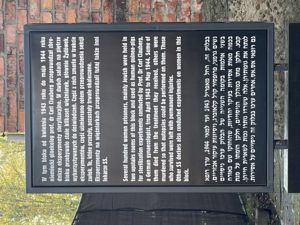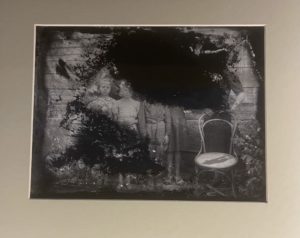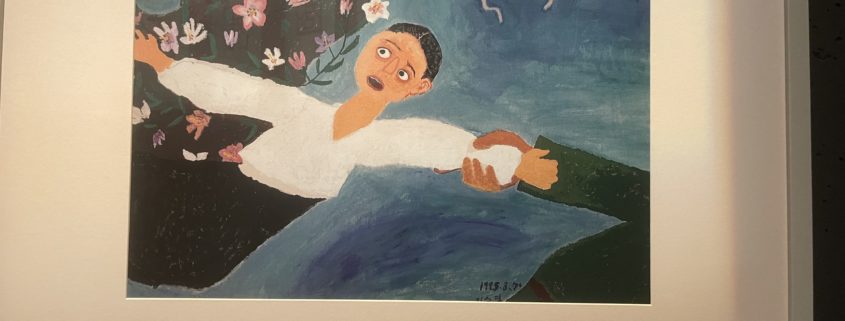Reclaiming Memory: The Forgotten Story of Pohulanka
By Katya Kauth
THE EVENT
 In July of 1946, eleven guards – six men and five women from the Stutthof Concentration Camp – were hung at a public execution site in front of 200,000 Gdańsk citizens. The attendees, some being survivors of the Stutthof camp, chanted and cheered as the former guards were transported to a field where six gallows were stationed. This execution site is known as Pohulanka, meaning, “violent party, a carnival of joy gone out of control” (Mendel 125). As the guards rolled in at 5 pm, nooses were tied around their necks by former Stutthof prisoners who were dressed in the striped uniforms they were forced to wear not long ago. With one swift signal, the crowd went into a loud and spirited uproar as trucks drove off leaving the former guards dangling in the air.
In July of 1946, eleven guards – six men and five women from the Stutthof Concentration Camp – were hung at a public execution site in front of 200,000 Gdańsk citizens. The attendees, some being survivors of the Stutthof camp, chanted and cheered as the former guards were transported to a field where six gallows were stationed. This execution site is known as Pohulanka, meaning, “violent party, a carnival of joy gone out of control” (Mendel 125). As the guards rolled in at 5 pm, nooses were tied around their necks by former Stutthof prisoners who were dressed in the striped uniforms they were forced to wear not long ago. With one swift signal, the crowd went into a loud and spirited uproar as trucks drove off leaving the former guards dangling in the air.
The guards had been found guilty of crimes against humanity and were sentenced to a humiliating public death. Leading up to the executions, government officials promoted the event, turning the day into a local holiday and making it clear to citizens that it was not to be missed. Adults and children of all ages were granted the day off from work or school, while transportation to the site was provided to those who could not get there on their own. The public hanging evoked anger and emotion. The onlookers heckled the guards. After the condemned had taken their last breaths, the crowd began attacking their limp bodies, collecting souvenirs, such as buttons or pieces of the ropes. When things had finally calmed down, the guards’ bodies were taken to the morgue and were later used to teach anatomy classes.
WHY THE RESPONSE
 For the residents of Gdańsk who witnessed and participated in this event, the overwhelming feeling of injustice motivated them to respond in a violent and vengeful way. Like many in Poland, the Gdańsk citizens had suffered directly from an abhorrent war. Some were survivors of Stutthof and other concentration camps; others had suffered due to mass displacement during and after the war. In postwar Gdańsk, many came from Vilnius, which before WWII was a part of Poland, and after, it became a part of the USSR. The constant changes to the border meant that they had lost their homes and communities. These profound losses perhaps explain, in part, the responses on that day. Having lived through a time when identity, humanity, security, and normalcy had been stripped from them for a grueling six years, they responded with emotional frenzy and violence. Violence perpetuates violence and in understanding this, perhaps we can begin to understand the actions of the citizens of Gdańsk on that day.
For the residents of Gdańsk who witnessed and participated in this event, the overwhelming feeling of injustice motivated them to respond in a violent and vengeful way. Like many in Poland, the Gdańsk citizens had suffered directly from an abhorrent war. Some were survivors of Stutthof and other concentration camps; others had suffered due to mass displacement during and after the war. In postwar Gdańsk, many came from Vilnius, which before WWII was a part of Poland, and after, it became a part of the USSR. The constant changes to the border meant that they had lost their homes and communities. These profound losses perhaps explain, in part, the responses on that day. Having lived through a time when identity, humanity, security, and normalcy had been stripped from them for a grueling six years, they responded with emotional frenzy and violence. Violence perpetuates violence and in understanding this, perhaps we can begin to understand the actions of the citizens of Gdańsk on that day.
BUILDING COMMUNITY
Shared experiences, especially those that are rooted in trauma, leave individuals who have been stripped of both their individuality and community desperate to build a new identity. The public hangings served as the foundation for the building of a postwar community in Gdańsk. Scholar Maria Mendel writes about this community-building role: “The collective witnessing of the unspeakable event of violence formed the platform over which a community now had something to share” (Mendel 124). After such exhausting emotional and physical turmoil, they finally had something in common, an experience that brought them together, putting an end to the past and creating a shared hope for their future and the future of their new community.
LONG TERM TRAUMA
 As the frenzy of emotion and the sense of urgency died down, many in the community were left with nothing but extreme shame, guilt, and trauma, which manifested into decades of silence. Their actions on July 4th, 1946, haunted them; it loomed over their consciences, becoming a trauma no one could or was willing to admit or discuss openly. They knew it was wrong to have yelled the cruel things they had while the guards were hung; they knew it was wrong to have taken the buttons off their clothes or ripped parts of their uniform off to keep as souvenirs. They had no choice but to live in the shadow of their shame. New generations of Gdańsk citizens inherited the trauma. Something horrible had happened at Pohulanka, but no one knew exactly what. These children claimed they had felt a haunting aura about the place and always had a feeling something was being hidden from them. Scholar Maria Mendel recalls as a child when she would pass the execution site, she was told to pray. “I was told by my mother to pray for the dead while we were passing Pohulanka on the bus… I was never told why” (Mendel 122).
As the frenzy of emotion and the sense of urgency died down, many in the community were left with nothing but extreme shame, guilt, and trauma, which manifested into decades of silence. Their actions on July 4th, 1946, haunted them; it loomed over their consciences, becoming a trauma no one could or was willing to admit or discuss openly. They knew it was wrong to have yelled the cruel things they had while the guards were hung; they knew it was wrong to have taken the buttons off their clothes or ripped parts of their uniform off to keep as souvenirs. They had no choice but to live in the shadow of their shame. New generations of Gdańsk citizens inherited the trauma. Something horrible had happened at Pohulanka, but no one knew exactly what. These children claimed they had felt a haunting aura about the place and always had a feeling something was being hidden from them. Scholar Maria Mendel recalls as a child when she would pass the execution site, she was told to pray. “I was told by my mother to pray for the dead while we were passing Pohulanka on the bus… I was never told why” (Mendel 122).
POST 1989
As time passed and communism fell in 1989, capitalism came barreling in. Undeveloped land such as the site of Pohulanka became an attractive investment. Because of its neglected history, it had become extremely overgrown with trees and other greenery, providing the perfect opportunity for developers to buy up the vast and abandoned land. To no surprise, that was exactly what happened, and by the early 2010s, a luxury apartment complex was erected, acting as both housing and a hotel[1]. By building on top of Pohulanka, forgetting became permanent, further enabling the town’s efforts to avoid remembering the traumatic events that occurred. It wasn’t until a Gdańsk-based artist intervened that the city and its citizens were forced to confront the tragedy.
BREAKING THE SILENCE
 Michał Łagowski, an artist and activist who felt passionately about the current state of Pohulanka Square, made a point to end the ongoing silence in an effort to actively remember the trauma the Gdańsk citizens experienced. In 2013, after the construction of the luxury housing complex, he embarked on a project that comprised of two events. The first event was the happening. Łagowski walked around the new building holding a replica of the gallows used for the hangings in 1946. The second event involved distributing postcards to the new residents which displayed a photo of the new apartment complex with the gallows next to it. The text at the top of the postcard read “Greetings From Pohulanka.”
Michał Łagowski, an artist and activist who felt passionately about the current state of Pohulanka Square, made a point to end the ongoing silence in an effort to actively remember the trauma the Gdańsk citizens experienced. In 2013, after the construction of the luxury housing complex, he embarked on a project that comprised of two events. The first event was the happening. Łagowski walked around the new building holding a replica of the gallows used for the hangings in 1946. The second event involved distributing postcards to the new residents which displayed a photo of the new apartment complex with the gallows next to it. The text at the top of the postcard read “Greetings From Pohulanka.”
Łagowski’s goal was to break the silence and end the stigma around this event. His work provoked a conversation among the new residents and interrupted their daily lives, making it impossible for them to continue living at this site ignorantly. I believe Łagowski undertook this artistic activism because he felt ashamed to live in a city that willingly forget such an upsetting event, seeing himself as an accomplice to the silence. Instead of continuing the generational silence, he turned this feeling of shame into activism.
Through this action, Łagowski reclaimed the site for the citizens of Gdańsk. Rather than remaining a site associated with ongoing shame and trauma that needed to be hidden, through his activism, Łagowski turned Pohulanka into a site of acknowledgement of the past. Pohulanka, today, is a place where people can remember the past, and come to terms with the tragic events that occurred there. Acceptance of the past has replaced the silence. A community built on truth and acceptance is much stronger than one built on silence and shame. Łagowski showed that silence and forgetting diminished the experiences of these citizens, in the end, persecuting them once again.
Works Cited
- Wikimedia Foundation. (2024, September 28). Stutthof concentration camp. Wikipedia. https://en.wikipedia.org/wiki/Stutthof_concentration_camp
- Mendel, M. (2013). Toward The Ignorant Gdańsk Citizen. In Education and the Political; New Theoretical Articulations(pp. 121–131). essay, Sense Publishers. Retrieved November 8, 2024,.
- Apartment Pohulanka Luxury Gdansk. Pohulanka Luxury Apartment Gdansk, Poland. (n.d.). https://pohulanka-luxury-apartment.gdanskhotel.org/en/#bkl
[1]Apartment Pohulanka Luxury Gdansk. Pohulanka Luxury Apartment Gdansk, Poland. (n.d.). https://pohulanka-luxury-apartment.gdanskhotel.org/en/#bkl



